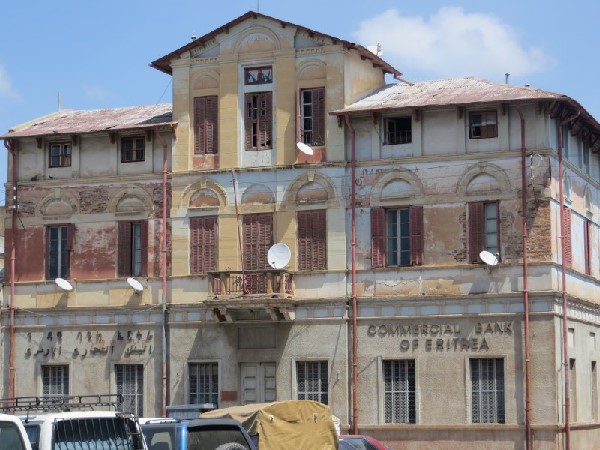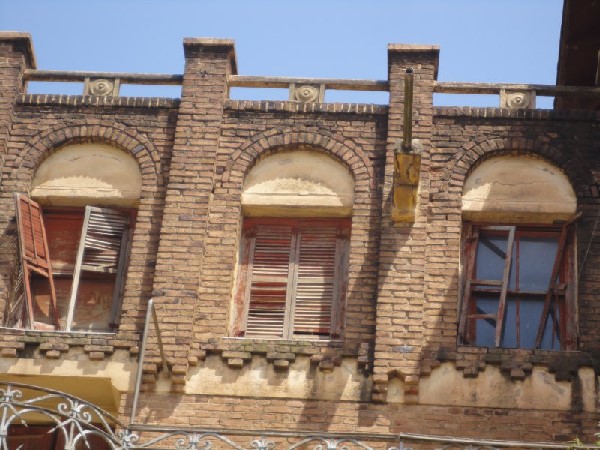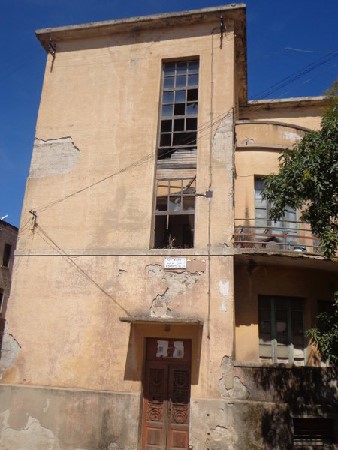Asmara’s Crumbling Buildings: Let the pictures speak- Part I
By Bana From Asmara
This email address is being protected from spambots. You need JavaScript enabled to view it.
Asmara’s Crumbling Buildings: Let the pictures speak- Part I
[Note from the editor: All in all, Bana from Asmara will provide us with more 2,000 pictures of dilapidated buildings from Asmara. The first batch - 406 altogether - are compiled in the video above. We will soon provide a blog for all the pictures in slide form, so that the reader can dwell on each of the photos. At the end of the articles, we have also provided a few samples below, at the end of the article.]
Asmara has many a time been hailed as one of the most beautiful and cleanest cities in Africa (www.asmara-architecture.com/Dossier_engl.pdf; I Didn’t Do It for You, Michela Wrong, 2005; Facts about Eritrea, Aradom Tedla, 1964). At times it has even been compared to cities in Europe. In the 1960’s the late Yonus Ibrahim sang Asmara’s praises putting it on a par with Paris and other European cities. Some of his lyrics went like this,
“Asmera ketema, tsebiqu edlki
hadisom melki’om kulom hntsatatki
mn’as Edenbra, n Paris mesilki
(city of Asmara, you have been bestowed favor
all your buildings are new and magnificent
you look a younger sister of Edinburgh and take after Paris. )
The particular era the singer referred to was one when Asmara was the hub of industrial and commercial activities, and enjoyed construction boom (thanks to Italian industrialists, entrepreneurs and developers as well as visionary and enterprising Eritreans such as Mayor Haregot Abay, Dejazmatch, who saw to it that the city moved with the times in harmony with its glorious architectural past). The time Yonus had in mind was also a time when Arab Emirs visited hospitals in Asmara for medical checkup as some people from Eritrea go to Dubai today for medical treatment. That was a time when Asmara’s main streets were flushed with water hoses week in, week out and Asmara reserved for itself the honor of being the first city in the world to introduce electrical-power driven trucks (www.unitedheartz.com/index.php/eri-guest/100-jhj).
Today, that time looks a far-fetched story. Asmara is only a shadow and a skeleton of its former self. Asmara’s acclaimed beauty and cleanliness is being reduced to a myth under the PFDJ gang in the face of increasing decay of its buildings, dilapidation of its infrastructure and fetid streets. A city that was spared the onslaught of battling armies in 1991 is now under the serious threat of disintegration in the hands of the so-called its own sons and daughters. What is the PFDJ up to?
The Italians who began to mould Asmara from a sprawling cluster of villages at the end of the nineteenth century laid down every conceivable system for a city life: buildings for residence, municipalities, offices, courthouses, palaces, markets, factories, industries, cinema halls, banks, hotels, cafés, sports facilities, parks, pavements, airports and amenities of all types such as power and telephone utilities, water supply, sewerage, and so on. Indeed they set up all these for their sheer comfort and pleasure and not essentially to serve the native population. As a matter of fact, our forefathers suffered subjugation and apartheid-like segregation in the hands of the Italians. That was the ugly face of colonialism. However, it is Eritreans who have finally inherited the rich architectural heritage of the Italians in Eritrea in general and in Asmara in particular.
The Italians brought together their pool of experts in the form of urban planners, master builders, and other related trades to transform Asmara to look like one of theirs in Italy. No wonder, many of Asmara’s buildings resembled those in Rome, Turin (Torino in Italian), Naples, Sabaudia, etc. There were even aspects in which Asmara surpassed Rome. For instance, in 1938 Asmara had more traffic lights than Rome as it was home to 50,000 vehicles (www.articles.chicagotribune.com/2003-11-23/news/0311230320_1; I Didn’t Do It for You, Michela Wrong, 2005).
How about today? Does Asmara yet fit its century-old image of a modern and clean city? What justice, if any, has the regime in power done to this beautiful city of which Eritreans and foreigners alike have fond but now fading memories?
The present chieftains in the country and, by extension, in the city, let alone to propel Asmara to march with the advances of the new age, have not even been able to maintain the quality of life and standard set by the Italians of old. We would not expect them to create an Asmara of the class of Dubai, New York or Cape Town. But failing to render the same services the Italians had on offer prior to the Second World War is a simple test of how badly the PFDJ have fared. Looking at the derelict state of buildings and infrastructure in today’s Asmara, one is left with the impression that the present Eritrean authorities might be determined to turn Asmara into the village it was at the start of Italian colonialism and to build it in God knows what style of their own. If in matters of historical and political identity the authorities in Eritrea have taken the country along a futile escape route from its historical roots (to borrow Yosief Gebrehiwet’s analysis on Asmarino: (I) The Circular Journey in Search of Eritrea: Journey Identity and (II) The Circular Journey in Search of Eritrea: A “World Distance” that Never Was), likewise in the area of architecture they are on the run to a strange style, perhaps a nihilistic one, away from the Italian legacy which has shaped our way of life and Asmara’s building style.
Asmara’s buildings which only forty, fifty years ago were the pride and joy of their citizens and the attraction of visitors are now falling to pieces. They are now succumbing to the elements, old age and utter neglect. It is not unnatural for buildings to grow old with the passage of time. That is why buildings periodically need professional inspection and renovation, particularly where they are historically significant. However, Asmara’s buildings have not been lucky to receive this much needed care and overhaul. They have been abandoned to degrade and fall apart. The level of degradation is so appalling that one is tempted to conclude it is being overlooked deliberately. The building plasters have peeled off looking oftentimes leprous skin and at other times new, festering wounds; the walls have been left stripped and are growing weak; cracks have formed and continue to form everywhere on the walls and other structures; the roofs have rusted away and some of them have fallen down; the building joinery (doors and windows) is broken and rickety; many of the glass panes are shattered and hanging in their places are plastic or clothing sheets, and so on. The pictures attached with this article speak for themselves. As the old adage goes, ‘A Picture Paints a Thousand Words.’ But, interspersed, the reader may find some too graphic and hence depressing pictures. Forgive me for those. One thing we should all be grateful, however, is that the stink of the places photographed has not been captured in the photos. The photos, grouped in order of their zonings in the city, have put on display the Asmara that is ailing, the Asmara that is hanging in the balance. Among other things, they counter the footages on EriTV such as ‘Eritrea… Simply magnificent’, ‘Erena’ and ‘Imagine’ which shroud the reality on the ground using doctored clips on Asmara and other places in Eritrea abusing modern-day effects in multimedia. When will the government own up to the reality and wake up for action? When buildings begin to collapse and wreck havoc?
Sampling some of the many buildings in Asmara which are decaying before the eyes of onlookers are:
The great Catholic Cathedral in the city centre is deteriorating both on the outside and inside. Its external plasters are crumbling and falling down with the inner walls exposed to the scourge of the sun, wind and rain; some of its bricks have begun cracking and fragmenting piece by piece; even its magnificent frescoes on the inside are giving in to dampness and decay.
The Mercato (The Vegetable and Fish Market in the centre of the city) has its ceilings and walls weakening with cracks and falling plasters.
The great cinema halls built in the style of the 1920’s and 1930’s Art Deco (also called Modernist or Rationalist design) have met similar ill fate. Cinema Capitol, Cinema Asmara, and Cinema Dante are cases in point.
- Cinema Capitol, which is the largest cinema hall in Asmara, exhibits awful decay in its external walls, concrete, and woodwork. Moulds have grown over its surface. But the most grisly deterioration of Cinema Capital is to be found within its four walls. Cinema Capitol is located only across the Presidential Palace. But inside the cinema hall, one finds destruction that evokes images of a gutted subterranean world. Many rows of the cinema seats have been violently removed with a part of the floor beneath them dug out; the unique retractable roof above the cinema hall is only a smashed opening replaced with cardboards where birds have piled up their excrement and through which the birds dive into the hall and smear the place with their droppings; a thick layer of these droppings has formed on the cinema floor which crunches as one walks over it; the ceiling and walls have been tainted with rain water and parts of the ceiling have fallen down; the remaining seats, the floor, the ceiling, the scarlet curtains have all been caked with dust and grime accumulated over many years; many curtains have been ripped up; the corridors and restrooms are simply putrefying. The whole atmosphere is one of disgust. This is a place that witnessed many a great event in its history. But today it is an eerily decrepit hall collecting rubbish. It has also been inhabited by squatters who are scattered in its storeys.What crime has Cinema Capitol committed to merit this level of abandonment?
- Cinema Asmara, in spite of its being – or perhaps because of its being - the daily rendezvous of the so-called regime artists (snetbebawyan, the regime propagandists) and snitches, is shedding its outer cover and suffering from cracks, moldy surfaces and its doors and windows are getting increasingly rotten. I suspect there are squatters living in its western and southern compounds.
- Cinema Dante, which happens to be one of the smallest cinema halls in Asmara, is pockmarked by falling wall layer. Besides, there is the stench that wafts from the inside and the outside.
This is just a status check on some of the cinemas in Asmara.
- The Municipality Hall in the centre of Asmara, which houses the office of the Mayor and which has been the emblematic building for the city, is losing its irreplaceable mosaic from the outside with patches of rain penetration on its front and sides. Some of its rooms give off putrid smell.
- The Ministry of Education, which from 1952 to 1962 served as the seat of the Eritrean Parliament of the Federation period, is crumbling from the top and the bottom and also on its left side which during the Federation era was the entrance to the assembly hall. As the building is located on the main thoroughfare called “Harnet (Liberty) Avenue”, its humid front and sides that are coming loose have become an eyesore to the public.
- The Ministry of Trade and Industry building on the Semaetat (Martyrs) Avenue is not spared either from the on-going dilapidation. Its imposing overhang on the front and its walls have become rusty and are chipping bit by bit.
- The Zerai Deres Commercial Bank (the old Banco Di Roma) is one of the buildings with visible wall plaster deterioration. Its window shutters have gone unhinged. Every time one looks at this particular bank its facade has assumed a more tarnished appearance. An unbecoming sight for a bank building.
- The main Commercial Bank of Eritrea on Liberty Avenue has been disfigured on its ceiling with the ceiling tiles peeling off and stains of dampness all over the place. Another branch of the Commercial Bank of Eritrea in Asmara getting so unpleasant to the eyes with damp and flaking surfaces is the one at Mieda Ertra.
- The colonnaded bus station near the Edaga Hamus Hospital is in serious disrepair. Its roof slab is splintering and God forbid its pieces may land on the passengers who spend the day lined up under its shade.
- The list of ‘endangered’ buildings in Asmara is very long. There are also landmark features in the city such as the Mai Jah Jah fountain which have come to stop functioning. Mai Jah Jah has long stopped from serving its cascading waterfalls and providing its cooling breeze to passersby during sunny days. It is left to collect litters in its five basins.
It has become dangerous to walk near many of the buildings in Asmara. There are walls leaning to the outside; walls and their protective coatings are seen bulging out and moving apart; the coatings are crashing on the sidewalks posing a danger to people and vehicles passing by. There are also walls left with gaping holes as if to invite the passerby to peek into the inside. There is no answerable government to stir action, nor do residents feel entitled to appeal to the government, for everything is politicized in the eyes of the PFDJ. Only those buildings which the government has divided as war booty to its most loyal sycophants by evicting civilians (an action which some Asmarinos have called ‘The Scramble for Asmara’) are being renovated. Whether their renovation meets the required standards is another most grave matter. For example, in many instances the renovation involves dismantling of antique doors, windows and fences and also tampering with the original façades and other unique features of historical buildings which, once damaged, are difficult to restore. At the time of this writing, a villa on the back of Ambassador Hotel at the corner facing the old Commissariat Park is being destroyed in the name of renovation by a tegadalit to whom the house has been rationed out. Years ago, I observed with anguish a similar defacing experiment at General Romadan Awliyay’s house which is situated right between the American Embassy and the Semaetat Secondary School (in a neighborhood built by the Italian developer Mario Mazzetti). The general, formerly head of Artillery Division and now Commissioner of Sports, demolished the beautiful brick fence enclosing his house and erected in its place an unsightly, rough faced wall to give shelter to the poultry he reared in his compound. Amid such acts of mindless harm, the Municipality of Asmara has been toothless to enforce its authority of safeguarding Asmara’s architectural excellence.
While the few houses that belong to party loyalists are remodeled so haphazardly, many houses in Asmara have gotten musty and asthmatic and pose a serious health hazard to their occupants. One preliminary study has suggested that 60% of the population in Asmara lives in uninhabitable (not suitable for living) houses which are rundown on the inside or outside; where a whole family with all its belongings is crammed in one room devoid of access to running water, proper or functioning toilet and in many instances a dozen families huddle in one compound served from one mogogo (oven house) and a single toilet.
The present discussion on the state of buildings in Asmara has its focus on buildings. But to skim over another languishing element of Asmara’s infrastructure, which is road pavement: the road pavements are in bad shape and worsening by the day. Many of the pavements have subsided (moved down) and stare at people and cars with their trademark potholes. The majority of drain pits (fognaturas), for which Asmara was famous in the past, have either broken covers, malfunctioned, or have been clogged with rubbish of all sorts (the images of drain pits presented herein require some fine-tuning until the eyes realize that they are actually looking at fognaturas.). The sidewalks too are losing their tiles with the earth underneath emerging as the new sidewalk. From a sanitation point of view, the sidewalks have also begun serving as the new public latrines. That is why one has to beware to walk on the sidewalks lest they should tread on human waste. It is commonplace to see pedestrian walkways stained with human excreta. To compound matters, there is an ongoing power cut in Asmara and darkness has engulfed the streets.
Still on the subject of roads, one concerned citizen’s comment on Hadas Ertra of September 10, 2012 posted at the bottom of page 8 is a clear testament to the terrible condition of pavements and sidewalks in Asmara. The said reader, after discreetly complaining about the awful condition of the road infrastructure in Asmara, has enumerated the problems emanating from the road deterioration such as increased traffic accidents, vehicle damage, fuel wastage and has gone as far as pointing out that it has been difficult to tell between the roadway and the walkway. A similarly restrained appeal added its voice on page 9, column 5 of Hadas Ertra of October 4, 2012.
Some of the above roads with big holes and ditches have been given nicknames by Asmarinos. One is called ‘Diga Gerset (Gerset Dam)’; another has been named ‘Ruba Hday (Hday River)’; there is one by the name ‘Eiraero’, so named for being a dark terrifying pit (Eiraero is the infamous PFDJ hellhole where dissenter former ministers and journalists have been locked up for years).













This email address is being protected from spambots. You need JavaScript enabled to view it.


![[AIM] Asmarino Independent Media](/images/logo/ailogo.png)